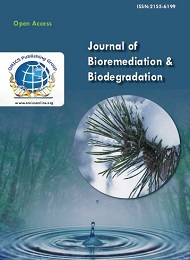Theme: Challenges and Solutions for the backbone of all ecosystems
Microbial Ecology 2018
Conference Series LLC LTD takes immense pleasure & feels honoured in inviting the contributors across the globe to attend 2nd International Conference on Microbial Ecology & Eco Systems to be held during July 11-12, 2018 at Toronto, Canada on the theme "Challenges and Solutions for the backbone of all ecosystems" which includes prompt keynote presentations, Oral talks, Poster presentations and Exhibitions.
Conference Series LLC LTD welcomes all the Microbiologist, Scientists, Research Scholars, Industrial professionals, Technologist and Student Delegates from Microbiology and Healthcare sectors to be a part of the esteemed Microbial Ecology- 2018. As this will be the best amalgamation of Academia and Research involving every aspect of Microbial Ecology. It is open to all types of Research methodologies both from Academia and Industry.
This year’s conference will showcase the roles of microbes in the different atmosphere by relating them to revolutionary science in the diverse area of microbiology through a wide range of scientific conference. The meeting is all set to be adorned by world-renowned speakers. All those who are either starting your career or an old-time microbiologist can attend this conference to learn, hook-up and get galvanized. We are looking forward to welcoming you all in Toronto.
Why to attend?
Microbial Ecology Conference is the indigenous knowledge which is the result of datum and experience collection of local individuals and societies in successive generations is a valuable body that should be considered for getting to sustainable development. Its success and resilience result from the profound influence that microorganisms have on life on Earth, sustaining our environment, influencing our health and driving many industrial biotechnology processes. Research areas that are marine and freshwater biogeochemical cycles and the influence of microbes on climate change through consumption and production of greenhouse gases, bioremediation of contaminated land and water, production of biofuels and use as biocatalysts, the importance of microbes in human health, interactions of microbes with animals and plants. Areas of microbiological research covered have an immense impact on the environment and mankind and thus Microbial Ecology remains a very vibrant and highly topical research field.
Why in Toronto, Canada?
Toronto is Canada's largest city, the fourth largest in North America, and home to a diverse population of about 2.8 million people. It's a global centre for business, finance, arts and culture and is consistently ranked one of the world's most livable cities. Toronto has a vibrant history of change and growth, ranging from its early occupation over 1,000 years ago to its current status as North America’s fourth-largest city. Toronto is Canada's largest municipality and is made up of the former cities of Toronto, North York, Scarborough, York and Etobicoke, and the former borough of East York. The city is home to a large immigrant population and is a national and international hub for finance, communications and cultural life. Diverse cultures, climates and landscape make Canada a destination to suit any interest. Canada is a country of immigrants and has a policy of encouraging diversity. Thus, urban hubs feature a range of ethnic neighbourhoods, restaurants, and shops. In addition to rich and varied urban centres, Canada’s natural environment is one of the most beautiful in the world. From pristine coastlines to rugged mountains and sparkling lakes, Canada’s geography inspires awe coast to coast.
The western side of Toronto is sometimes only thought of a place where industry and residences bump up against each other, but it is also a place where there are wonderful parks and waterways and where numerous pockets of small businesses and local spirit create active and diverse communities. Combining suburban enclaves and malls with condominium developments and the dense business district surrounding the North York Civic Centre, the north-central tip of Toronto is at once both relaxed and exciting. The area is also home to York University and Black Creek Pioneer Village.
Target Audience:
• Scientists
• Students
• Researchers
• Faculties
• Environmental Microbiology institutes
• Associations and Societies
• Research Labs
• Industrial delegates from Academia
• Advertisers and Sponsors
Conference Series LLC LTD is an online open access publisher and a scientific event organizer, announcing its 2nd International Conference on Microbial Ecology & Eco Systems during July 11-12, 2018 at Toronto, Canada. Conference theme is “Challenges and Solutions for the backbone of all ecosystems”. This interesting event is managed in such a way to provide an exclusive platform for educators, new researchers, and learners to present and discuss the most recent innovations, possibilities, and concerns adopted in the field of Microbial Ecology & Eco Systems. Microbial Ecology 2018 will comprise an informative and exciting conference program including leading keynote speakers, poster presenters, session speakers who will be presenting their research on the topics related to Microbial Ecology & Eco Systems.
Therefore we invite you heartedly to join us at the Microbial Ecology 2018, where you will be sure to have a great experience with experts from around the world. All the important members of Microbial Ecology 2018 organizing committee look further to meet you in Toronto, Canada.
Track: 1- Microbial Ecology
Microbial Ecology is the study of microbes and their relationship with each other in given surroundings. Microbes are the smallest creatures on Earth, yet despite their very little size, they have a huge impact on our surroundings. Microorganisms, by their ubiquitous, impact the complete biosphere and plays a primary role in regulating biogeochemical systems in virtually all of our planet's surroundings, including some of the most extreme, from frozen environments and acidic lakes, to hydrothermal at the bottom of deepest oceans, and some of the most familiar, such as the human small intestine.
Track: 2- Public Health Microbiology
The Public Health and Microbiology concentration comprises research in microbial pathogenesis, principles of public health, epidemiology, molecular genetics, virology, and environmental and industrial microbial processes. This concentration prepares students for technical work or graduate school in microbial disease systems using polymerase chain reaction, other molecular diagnostic tools as well as environmental and industrial applications of microbial systems.
Track: 3- Evolution of microbial lives
Microorganisms are called microbes for short. This class of life forms includes cellular life forms as well as the non-living crystals called viruses that parasitize living cells. The category called microbes includes viruses, bacteria, protists, some forms of fungus organisms and a few simple members of the animal kingdom. Microbes exist everywhere in abundance. Most are not harmful but some in the category are known as pathogens and are harmful. The term pathogen indicates disease causing.
Track: 4- Love, hate and cheating: microbe-microbe interactions
Like organisms in any ecosystem, the microbes in the human body continually interact with one another, both directly and indirectly (the proteins and metabolites they engender are withal in constant interplay). Microbial communities exhibit synergistic interactions for enhanced bulwark from host defences, nutrient acquisition, and assiduousness in an inflammatory environment. Hundreds of different microbes persist in a single biofilm community. More virulent bacteria can forfend the biofilm from outside intrusion while other species inside the polymeric matrix fixate on obtaining nutrients for the community. As the biofilm forms and then develops, the collective genetic expression of microbes in the ecosystem changes significantly.
Track: 5- Meta-ome information to microbial ecology
Metagenomic approaches are now commonly used in microbial ecology to study microbial communities in more detail, including many strains that cannot be cultivated in the laboratory. Bioinformatic analyses make it possible to mine huge metagenomic datasets and discover general patterns that govern microbial ecosystems. Metaproteomics proposed for the large-scale characterization of the entire protein complement of environmental microbiota at a given point in time. Two thousand and thirty-three proteins from the five most abundant species in the biofilm were detected, including 48% of the predicted proteins from the dominant biofilm organism Leptospirillum group II.
Track: 6- Microbial eukaryotes
Most living things that are visible to the unclad ocular perceiver in their adult form are eukaryotes, including humans. However, a sizably voluminous number of eukaryotes are withal microorganisms. Microbial eukaryotes are a consequential component of the human gut microbiome. Eukaryotes that reside in the human gut are dispersed across the eukaryotic tree and their relationship with the human host varies from parasitic to opportunistic to commensal to mutualistic. Eukaryotes are one of the three domains of life and are defined by the presence of nuclei. Animals, plants, and fungi are the most visible clades of eukaryotes, but these are just three of the 70+ lineages, most of which are microbial.
Track: 7- Effects of climate change on microbial community
Ecumenical change is altering species distributions and thus interactions among organisms. Organisms live in concert with thousands of other species, some benign, some pathogenic, some which have little to no effect in intricate communities. Since natural communities are composed of organisms with very different life history traits and dispersal competency it is unlikely they will all respond to climatic transmutation in a kindred way. Disjuncts in plant-pollinator and plant-herbivore interactions under ecumenical change have been relatively well described, but plant-soil microorganism and soil microbe-microbe relationships have received less attention. Since soil microorganisms regulate nutrient transformations, provide plants with nutrients, sanction co-esse among neighbours, and control plant populations, transmutations in soil microorganism-plant interactions could have paramount ramifications for plant community composition and ecosystem function.
Track: 8- BBB- Bioremediation, Biodeterioration, Biodegradation
Many industrial processes engender contaminated wastewater capable of causing earnest ecological harm that may result in heftily ponderous fines and prosecution if relinquished into the environment without felicitous pre-treatment. Conventional treatment systems can be very sumptuous to build and operate. MBD Energy offers industry partners potential for cost-preserving pre-treatment or full bioremediation (depending on the contamination type and rigour), together with the potential for the engenderment of valuable biomass and algae predicated products. Whether utilising cull strains of algae or bacteria, all MBD’s bioremediation solutions harness the puissance of nature to biologically convert industrial waste into biomass, which can be utilized for fuel, fertiliser, victuals or ailment – depending on the contamination type. Albeit bioremediation holds great promise for dealing with intractable environmental quandaries, it is consequential to agnize that much of this promise has yet to be realized. Concretely, much needs to be learned about how microorganisms interact with different hydrologic environments. As this understanding increases, the efficiency and applicability of bioremediation will grow rapidly. Because of its unique interdisciplinary expertise in microbiology, hydrogeology, and geochemistry, the USGS will perpetuate to be at the forefront of this exhilarating and rapidly evolving technology.
Biodegradation is nature's way of recycling wastes or breaking down organic matter into nutrients that can be utilized by other organisms. "Degradation" denotes decay, and the "bio-" prefix betokens that the decay is carried out by an immensely colossal assortment of bacteria, fungi, insects, worms, and other organisms that victual dead material and recycle it into incipient forms. In nature, there is no waste because everything gets recycled. The waste products from one organism become the aliment for others, providing nutrients and energy while breaking down the waste organic matter. Some organic materials will break down much more expeditious than others, but all will eventually decay. By harnessing these natural forces of biodegradation, people can reduce wastes and emaculate some types of environmental contaminants. Through composting, we expedite natural biodegradation and convert organic wastes to a valuable resource. Wastewater treatment additionally expedites natural forces of biodegradation. In this case, the purport is to break down organic matter so that it will not cause pollution quandaries when the dihydrogen monoxide is relinquished into the environment. Through bioremediation, microorganisms are acclimated to emaculate oil spills and other types of organic pollution. Composting and bioremediation provide many possibilities for student research.
Track: 9- Biogeochemical cycles
A biogeochemical cycle or substance turnover is a pathway by that a chemical substance moves through both the biotic (biosphere) and abiotic (lithosphere, atmosphere, and hydrosphere) components of Earth. A cycle is a series of transmuting which comes back to the commencement point and which can be reiterated. The term "biogeochemical" tells us about the biological, geological and chemical factors. The circulation of chemical nutrients like carbon, oxygen, nitrogen, phosphorus, calcium, and dihydrogen monoxide etc. through the biological and physical world are kenned as "biogeochemical cycles".
Track: 10- Agriculture Microbiology
Agricultural microbiology is a branch of microbiology dealing with plant-associated microbes and plant and animal diseases. It withal deals with the microbiology of soil fertility, such as microbial degradation of organic matter and soil nutrient transformations.
Track: 11- Microbial Biofilm
A biofilm is an amassment of microbial communities enclosed by a matrix of extracellular polymeric substance (EPS) and dissevered by a network of open dihydrogen monoxide channels. These communities adhere to manmade and natural surfaces, such as metals and teeth, typically at a liquid-solid interface. Their architecture is an optimal environment for cell-cell interactions, including the intercellular exchange of genetic material, communication signals, and metabolites, which enables diffusion of obligatory nutrients to the biofilm community. The matrix in which microbes in a biofilm are embedded forfends them from UV exposure, metal toxicity, acid exposure, dehydration and salinity, phagocytosis, antibiotics, and antimicrobial agents. The protective EPS and the unsurpassed metabolic multifariousness and phenotypic plasticity of microbes, likely expound how bacteria are able to persist in so many variants of environments, including those that are inhospitable to higher forms of life. By composing organized communities with other microbes, they can even further elongate their competency to acclimate and thrive in even the most truculent environments.
Microbiology impacts the world greatly, mainly to treat major pandemics and common infections, and also affects the food people consume and the manufacture of key industrial products. Such a broad field requires a necessarily broad survey of the market opportunities and challenges that will arise in coming years.
In today's economic climate your business decisions are as crucial as ever. The 2nd International Conference on Microbial Ecology & EcoSystems is an exciting opportunity to showcase the new technology, the new products of your company, and/or the service your industry may offer to a broad international audience. Conference Series LLC LTD welcomes all the Microbiologist, Scientists, Research scholars, Industrial professionals and student delegates from Microbiology and Healthcare sectors to be a part of the esteemed Microbial Ecology 2018. As this will be the best amalgamation of academia and research involving every aspect of Microbial Ecology. It is open to all types of research methodologies both from academia and industry.
Why in Toronto?
Toronto is Canada's largest city, the fourth largest in North America, and home to a diverse population of about 2.8 million people. It's a global centre for business, finance, arts and culture and is consistently ranked one of the world's most livable cities. Toronto has a vibrant history of change and growth, ranging from its early occupation over 1,000 years ago to its current status as North America’s fourth largest city. Toronto is Canada's largest municipality and is made up of the former cities of Toronto, North York, Scarborough, York and Etobicoke, and the former borough of East York. The city is home to a large immigrant population and is a national and international hub for finance, communications and cultural life. Diverse cultures, climates and landscape make Canada a destination to suit any interest. Canada is a country of immigrants and has a policy of encouraging diversity. Thus, urban hubs feature a range of ethnic neighbourhoods, restaurants, and shops. In addition to rich and varied urban centres, Canada’s natural environment is one of the most beautiful in the world. From pristine coastlines to rugged mountains and sparkling lakes, Canada’s geography inspires awe coast to coast.
The western side of Toronto is sometimes only thought of as the place where industry and residences bump up against each other, but it is also a place where there are wonderful parks and waterways and where numerous pockets of small businesses and local spirit create active and diverse communities. Combining suburban enclaves and malls with condominium developments and the dense business district surrounding the North York Civic Centre, the north-central tip of Toronto is at once both relaxed and exciting. The area is also home to York University and Black Creek Pioneer Village.
Global Market Research Report:
The global microbial identification market is expected to reach USD 3.00 Billion by 2022 from USD 2.18 Billion in 2017, at a CAGR of 6.6%.
Factors driving the growth of this market include the increasing prevalence of infectious diseases, technological advancements in microbial identification, increasing food safety concerns, and government initiatives to promote the use of microbial identification.
“Consumables segment expected to grow at the fastest rate during the forecast period”
The consumables used for microbial identification are anticipated to grow at the highest CAGR during the forecast. The need of consumables in large numbers as compared to instruments is the primary factor responsible for this positive market growth.
“The diagnostic applications segment is anticipated to grow at the fastest growth rate during the forecast period”
The microbial identification market by application is categorized into diagnostic applications (human disease diagnosis and animal disease diagnosis), food testing, beverage testing, cosmetics and personal care products testing, pharmaceutical applications, environmental applications, and other applications. The diagnostic applications segment is estimated to grow at the fastest rate during the forecast period. Increasing use of microbial identification for the diagnosis of infectious diseases in humans and animals is the key factor driving the growth of this market.
“The proteomics-based methods segment is estimated to grow at a rapid rate during the analysis period”
By the method, the microbial identification market is segmented into phenotypic, genotypic, and proteomics-based methods. The proteomics-based methods segment is the fastest growing segment of the global microbial identification market on the basis of the method. The rising demand for proteomics-based methods on account of greater levels of sensitivity, accuracy, and specificity is driving the demand for this segment.
The global agricultural microbial market was valued at US$2.849 billion in 2017 and is expected to grow at a CAGR of 13.60% to reach a market size of US$5.390 billion by the year 2022. The global market for microbes is being driven on account of increasing pressure across the globe for rising production of food owing to the constantly growing global population. Other factors such as the requirement of environment-friendly farming practices and supportive microbe's regulatory policies further contribute to the market growth.
The global microbial biosurfactants market is estimated to expand at a CAGR of 4% during the period between 2017 and 2021. The global microbial biosurfactants market to be worth US$17.7 mn by 2021. The usage of biobased cleaning products has propelled the growth of the global microbial biosurfactants market.
Geographically, the microbial market is dominated by North America ( Canada, United States and Mexico), followed by Europe in 2017. Asia is estimated to grow at the fastest rate which can be attributed to developing healthcare infrastructure, rising burden of infectious diseases, and increasing initiatives to promote the use of novel technologies for microbial identification.
The key players in the market of Microbial products vary on the basis of industries. Following companies belong to different industry and are directly connected with the microbial product:
- Valent BioSciences Corp.
- LAM International
- BioOrganics Inc.
- Mycorrhizal Applications Inc.
- METabolic EXplorer S.A.
- Procter & Gamble Co.
- Lesaffre et Compagnie
- Novo Nordisk A/S
- Amyris Inc.
- Gevo
- REG Life Sciences LLC
- Desert Sweet Biofuels
- Natural Environmental Systems LLC
- Bioremediation Inc.
- BIO-SYSTEMS International
- Sapporo Breweries Ltd.
- BASF
- Bayer
- DuPont
- Novozymes
- ABM
- BIO-CAT
- BrettYoung
- Hancock Seed
- Precision Laboratories
- TerraMax
- Verdesian Life Sciences
- XiteBio Technologies
Keeping in view of increased security measures, we would like to request all the participants to apply for Visa as soon as possible.
Conference Series LLC LTD will not directly contact embassies and consulates on behalf of visa applicants. All delegates or invitees should apply for Business Visa only.
Important note for failed visa applications: Visa issues cannot come under the consideration of cancellation policy of Conference Series LTD including the inability to obtain a visa.
Conference Highlights
- Recycling
- Public Health Microbiology
- Evolution of microbial lives
- Microbial interactions
- Metagenomics
- Effects of climate change on microbial community
- Hazardous waste management
- Biogeochemical cycles
- Carbon cycle and Bioenergy
- Microbial Biofilms
- Pollution control and Global Warming
- Microbial eukaryotes
- Host-pathogen interactions
- Soil Microbiology
- Antimicrobials
- Food microbiology
- Plant and Agricultural Microbiology
- Applied Microbiology
To share your views and research, please click here to register for the Conference.
To Collaborate Scientific Professionals around the World
| Conference Date | July 11-12, 2018 | ||
| Sponsors & Exhibitors |
|
||
| Speaker Opportunity Closed | Day 1 | Day 2 | |
| Poster Opportunity Closed | Click Here to View | ||
Useful Links
Special Issues
All accepted abstracts will be published in respective Our International Journals.
- Journal of Microbial & Biochemical Technology
- Journal of Bioremediation & Biodegradation
- VEGETOS: An International Journal of Plant Research
Abstracts will be provided with Digital Object Identifier by












































